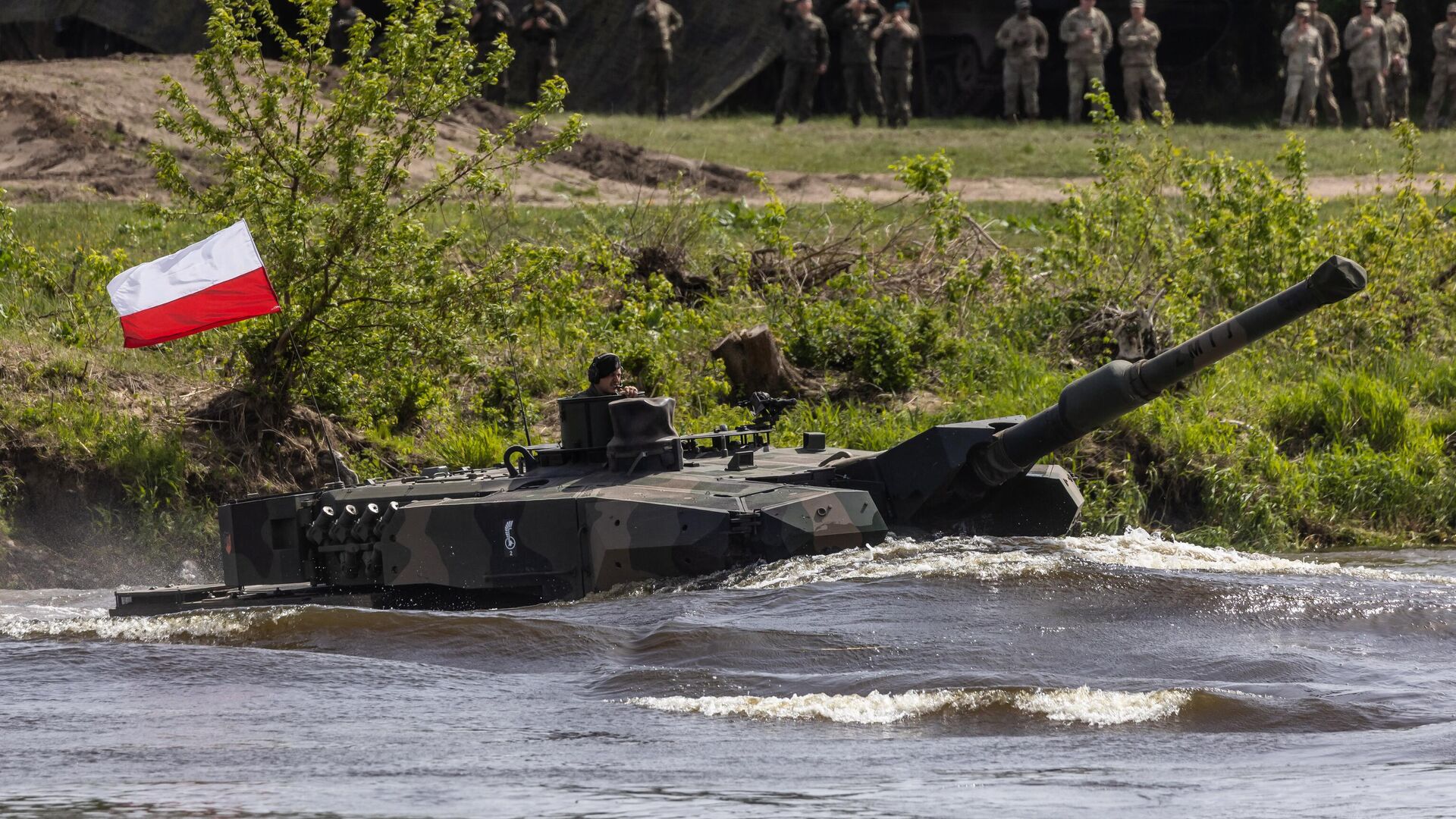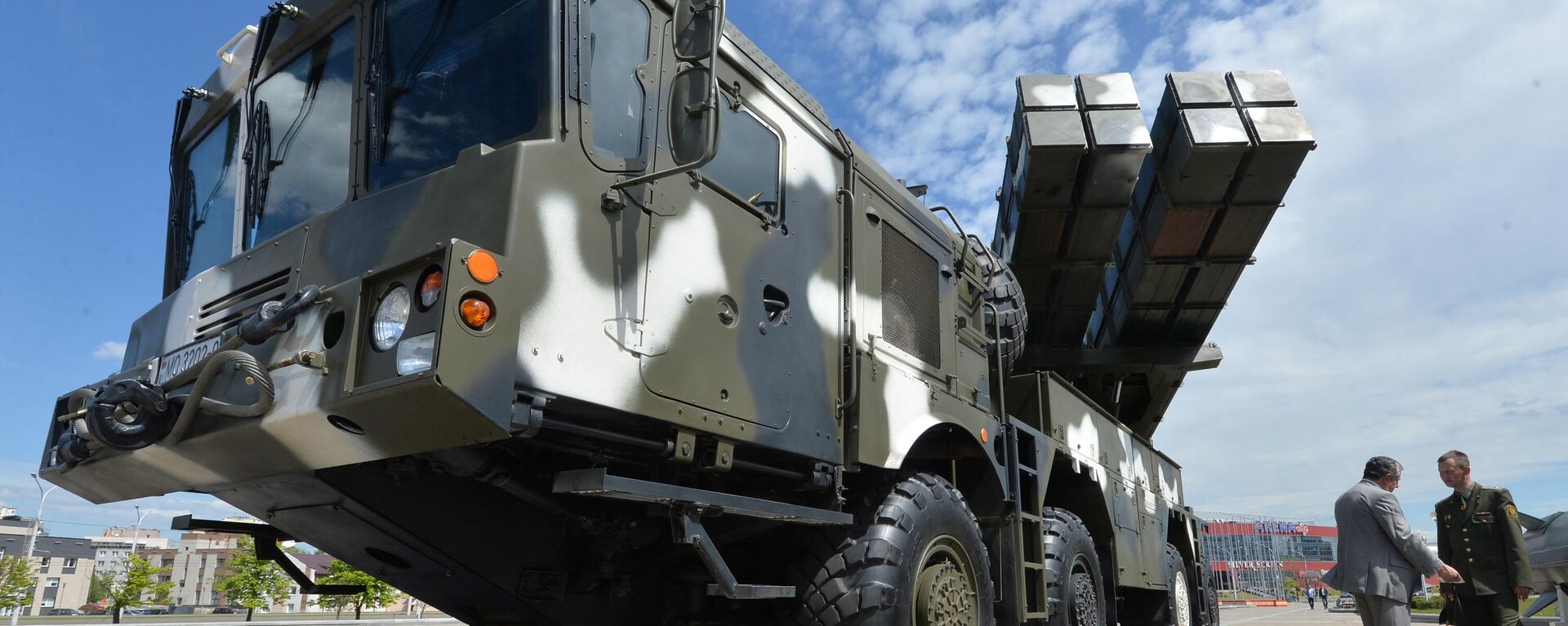https://sputnikglobe.com/20240803/border-defense-or-invasion-springboard-why-is-poland-massing-troops-on-frontier-with-belarus-1119624928.html
Border Defense or Invasion Springboard: Why is Poland Massing Troops on Frontier With Belarus?
Border Defense or Invasion Springboard: Why is Poland Massing Troops on Frontier With Belarus?
Sputnik International
Poland kicked off a large-scale military operation along the border with Belarus on August 1, ostensibly to secure the frontier in the face of what Defense Minister Wladyslaw Kosiniak-Kamysz characterized as a migrant-fueled “hybrid war” against Warsaw. Why does Minsk have reason to be wary of Warsaw's official justifications?
2024-08-03T15:55+0000
2024-08-03T15:55+0000
2024-08-03T15:55+0000
analysis
alexander lukashenko
wladyslaw kosiniak-kamysz
military & intelligence
europe
poland
belarus
warsaw
nato
european union (eu)
https://cdn1.img.sputnikglobe.com/img/07e8/08/03/1119625443_0:161:3070:1888_1920x0_80_0_0_687be548b4cb909f0ef69dcf923ec9ea.jpg
The Polish border defense operation, dubbed ‘Safe Podlasie’ (referring to the northeastern Polish province of Podlaskie) involves about 17,000 troops led by the 18th Mechanized Division of the Polish Armed Forces, with the officially-stated aim of the deployment being to fight illegal migrant flows in a dispute with Belarus that goes back to 2021.Poland has already built a 186 km long, five-meter high, $400 million anti-immigration border fence along part of the border, and plans to construct a massive, 200-meter to 2 km-wide “buffer zone” at some point in the future.But Operation ‘Safe Podlasie’ was kicked off simultaneously with Operation Eastern Aurora, a NATO mission ostensibly meant to secure Polish airspace “in the face of unpredictable Russian actions,” thus potentially betraying Warsaw’s true intentions and rationale for the troop buildup.Belarus has long been skeptical of Warsaw’s military deployments on its western frontier. With over 216,000 personnel under arms (the Belarusian military has about 65,000 troops total, for comparison), Poland has the third-largest military in NATO after the US and Turkiye, and has dramatically ramped up the deployment of alliance assets and troops (including a new American missile defense facility in Redzikowo, northern Poland with offensive capabilities) in recent years. In March, Poland hosted the Dragon 24 wargames, involving some 20,000 NATO troops and 3,500 pieces of military equipment.Successive Polish governments have had long-standing ambitions to topple Belarusian President Alexander Lukashenko to install a more European Union and NATO-friendly government, sponsoring and lending other forms of aid to radical opposition forces in the country, most recently in 2020.Some Polish geostrategists see Belarus as a key piece of the ‘Intermarium’, a geopolitical concept first conceived by Polish statesman Jozef Pilsudski in the first part of the 20th century to ‘reunite’ the territories of the old Polish-Lithuanian Commonwealth to contain Russia from the Baltic to the Black Seas.Some Poles also consider the lands of western Belarus as the Polish ‘borderlands’. In 2020, Lukashenko accused Warsaw of harboring plans to annex Grodno region amid the foreign-backed post-election unrest facing Belarus at the time. The Polish government vocally denied the claims.Lukashenko warned in an address to the All-Belarusian People’s Assembly in April that the threats to Belarus from Poland and the Baltic States has increased dramatically in recent years.“As for the combat units of the Polish Armed Forces on the border with Belarus, under the pretext of ‘strengthening security’, the military is solving reconnaissance and sabotage tasks. Poland intends to create ‘the most powerful ground forces in Europe’, with the military-technical support of the United States, of course. Warsaw is steadily increasing the size of its armed forces: by 2035 it is planned to increase their size to 300,000 people,” the Belarusian president added.Belarusian authorities have said repeatedly that they, on their part, have no intentions to launch aggression against Poland or any other NATO members.But Minsk has also warned that it would respond forcefully to any provocations by the alliance, and has ramped up joint exercises with Russia (and recently, China) and deployed Russian tactical nuclear weapons in the country. Belarus has fought hard to avoid becoming directly entangled in the NATO-Russia proxy war in Ukraine despite repeated provocations from its southern neighbor, with Lukashenko saying Belarus would instead serve as a reliable buffer against direct NATO on Russia’s western’s frontier.
https://sputnikglobe.com/20240710/poland-to-deploy-17000-troops-to-guard-eastern-border-1119326051.html
https://sputnikglobe.com/20240702/belarus-air-defense-forces-including-polonez-iskander-on-high-alert-amid-ukrainian-border-tensions-1119224786.html
https://sputnikglobe.com/20240522/polish-army-ready-to-increase-number-of-troops-on-eastern-border-1118585967.html
https://sputnikglobe.com/20240510/lukashenko-says-no-one-needs-neither-dollar-nor-euro-1118370395.html
poland
belarus
warsaw
Sputnik International
feedback@sputniknews.com
+74956456601
MIA „Rossiya Segodnya“
2024
News
en_EN
Sputnik International
feedback@sputniknews.com
+74956456601
MIA „Rossiya Segodnya“
Sputnik International
feedback@sputniknews.com
+74956456601
MIA „Rossiya Segodnya“
why is poland putting troops on border with belarus, will poland attack belarus, will belarus attack poland, will belarus attack nato, will nato attack belarus
why is poland putting troops on border with belarus, will poland attack belarus, will belarus attack poland, will belarus attack nato, will nato attack belarus
Border Defense or Invasion Springboard: Why is Poland Massing Troops on Frontier With Belarus?
Poland kicked off a large-scale military operation along the border with Belarus on August 1, ostensibly to secure the frontier in the face of what Defense Minister Wladyslaw Kosiniak-Kamysz characterized as a migrant-fueled “hybrid war” against Warsaw. Why does Minsk have reason to be wary of Warsaw's official justifications?
The Polish border defense operation, dubbed ‘Safe Podlasie’ (referring to the northeastern Polish province of Podlaskie) involves about 17,000 troops led by the 18th Mechanized Division of the Polish Armed Forces, with the officially-stated aim of the deployment being to fight illegal migrant flows in a dispute with Belarus that
goes back to 2021.
“Our soldiers will counter illegal crossings in places that are not intended for this. This operation is a response to illegal immigration from the east, which poses a challenge to Poland’s internal security,” Kosiniak-Kamysz said ahead of the deployment.
Poland has already built a 186 km long, five-meter high, $400 million anti-immigration border fence along part of the border, and plans to construct a massive, 200-meter to 2 km-wide “buffer zone” at some point in the future.
But Operation ‘Safe Podlasie’ was kicked off simultaneously with Operation Eastern Aurora, a NATO mission ostensibly meant to secure Polish airspace “in the face of unpredictable Russian actions,” thus potentially betraying Warsaw’s true intentions and rationale for the troop buildup.
Belarus has long been skeptical of Warsaw’s military deployments on its western frontier. With over 216,000 personnel under arms (the Belarusian military has about 65,000 troops total, for comparison), Poland has the third-largest military in NATO after the US and Turkiye, and has dramatically ramped up the deployment of alliance assets and troops (including a new American missile defense facility in Redzikowo, northern Poland
with offensive capabilities) in recent years. In March, Poland hosted the Dragon 24 wargames, involving some 20,000 NATO troops and 3,500 pieces of military equipment.
Successive Polish governments have had
long-standing ambitions to topple Belarusian President Alexander Lukashenko to install a more European Union and NATO-friendly government, sponsoring and lending other forms of aid to radical opposition forces in the country, most recently in 2020.
Some Polish geostrategists see Belarus as a key piece of the
‘Intermarium’, a geopolitical concept first conceived by Polish statesman Jozef Pilsudski in the first part of the 20th century to ‘reunite’ the territories of the old Polish-Lithuanian Commonwealth to contain Russia from the Baltic to the Black Seas.
Some Poles also consider the lands of western Belarus as the
Polish ‘borderlands’. In 2020, Lukashenko accused Warsaw of
harboring plans to annex Grodno region amid the foreign-backed post-election unrest facing Belarus at the time. The Polish government vocally denied the claims.
Lukashenko
warned in an address to the All-Belarusian People’s Assembly in April that the threats to Belarus from Poland and the Baltic States has increased dramatically in recent years.
“We see how, across our western borders, airfields, naval bases and training grounds are being improved at an accelerated pace, forward bases are being created for the advance placement and storage of equipment, weapons and materiel. To date, five airfields, two naval bases and six large training grounds have been modernized in Poland and the Baltic states,” Lukashenko said, pointing out that the upgraded NATO warehouses near the town of Powidz, central Poland alone are designed to store nearly 3,000 pieces of alliance military equipment.
“As for the combat units of the Polish Armed Forces on the border with Belarus, under the pretext of ‘strengthening security’, the military is solving reconnaissance and sabotage tasks. Poland intends to create ‘the most powerful ground forces in Europe’, with the military-technical support of the United States, of course. Warsaw is steadily increasing the size of its armed forces: by 2035 it is planned to increase their size to 300,000 people,” the Belarusian president added.
“It’s clear that the territory of Poland and the Baltic countries is being purposefully turned into a military springboard for possible use by the NATO bloc. That is, almost everything has been done to prepare the leadership of the alliance for the decision to use military force, including extreme military force,” Lukashenko warned.
Belarusian authorities have said repeatedly that they, on their part, have no intentions to launch aggression against Poland or any other NATO members.
But Minsk has also warned that it would respond forcefully to any provocations by the alliance, and has ramped up joint exercises with Russia (and recently, China) and
deployed Russian tactical nuclear weapons in the country. Belarus has fought hard to avoid becoming directly entangled in the NATO-Russia proxy war in Ukraine despite repeated provocations from its southern neighbor, with Lukashenko saying Belarus would instead serve as a reliable buffer against direct NATO on Russia’s western’s frontier.






